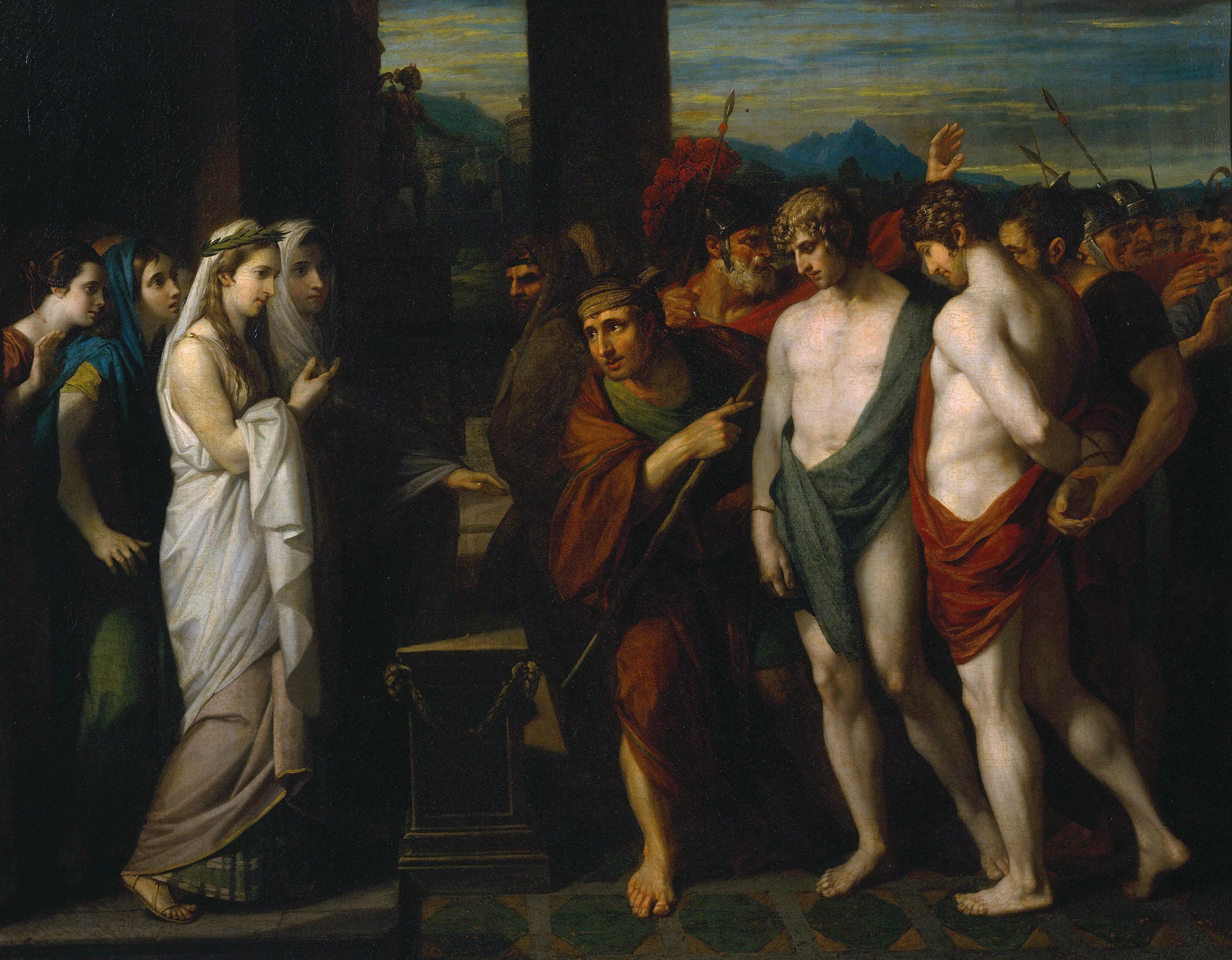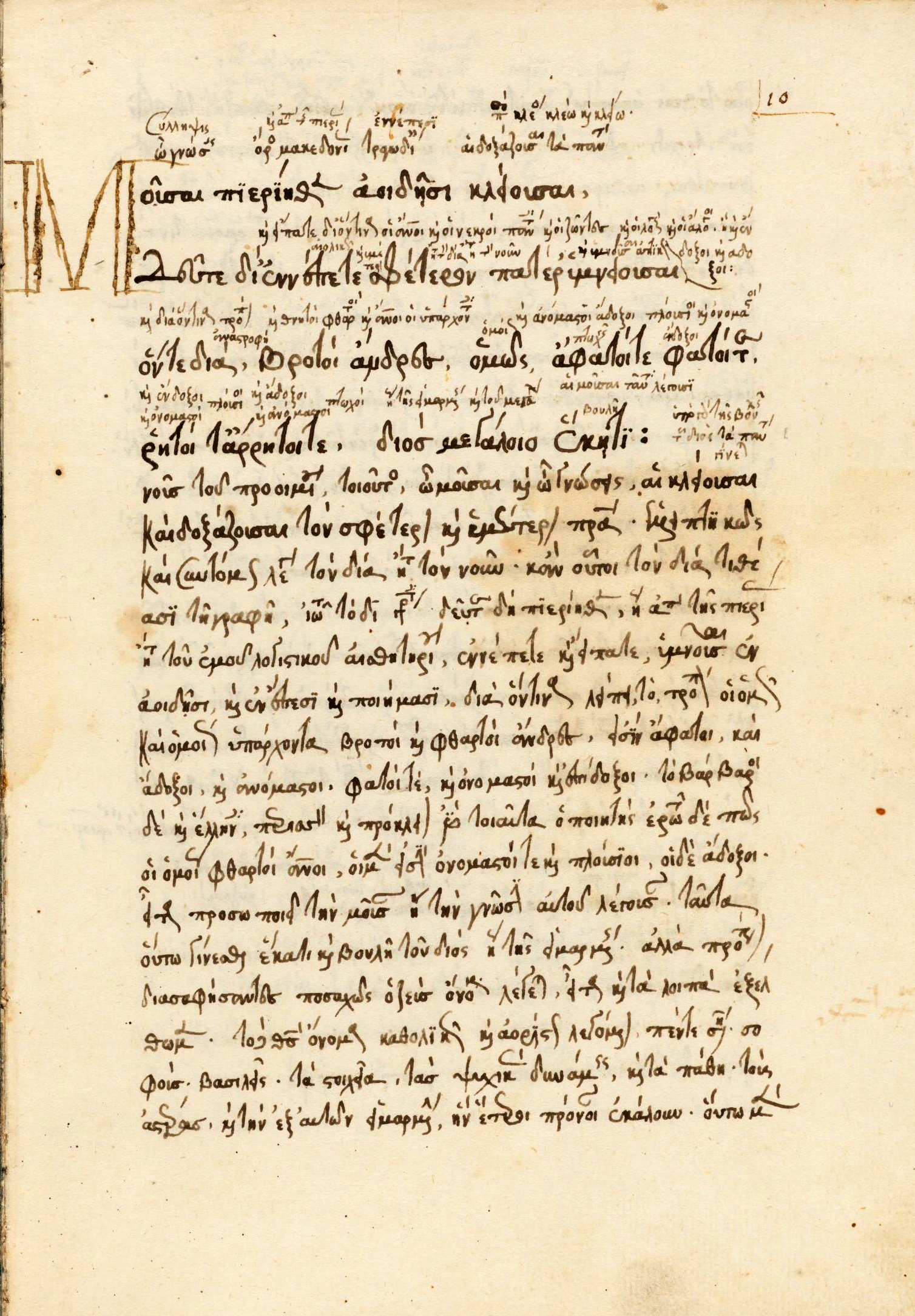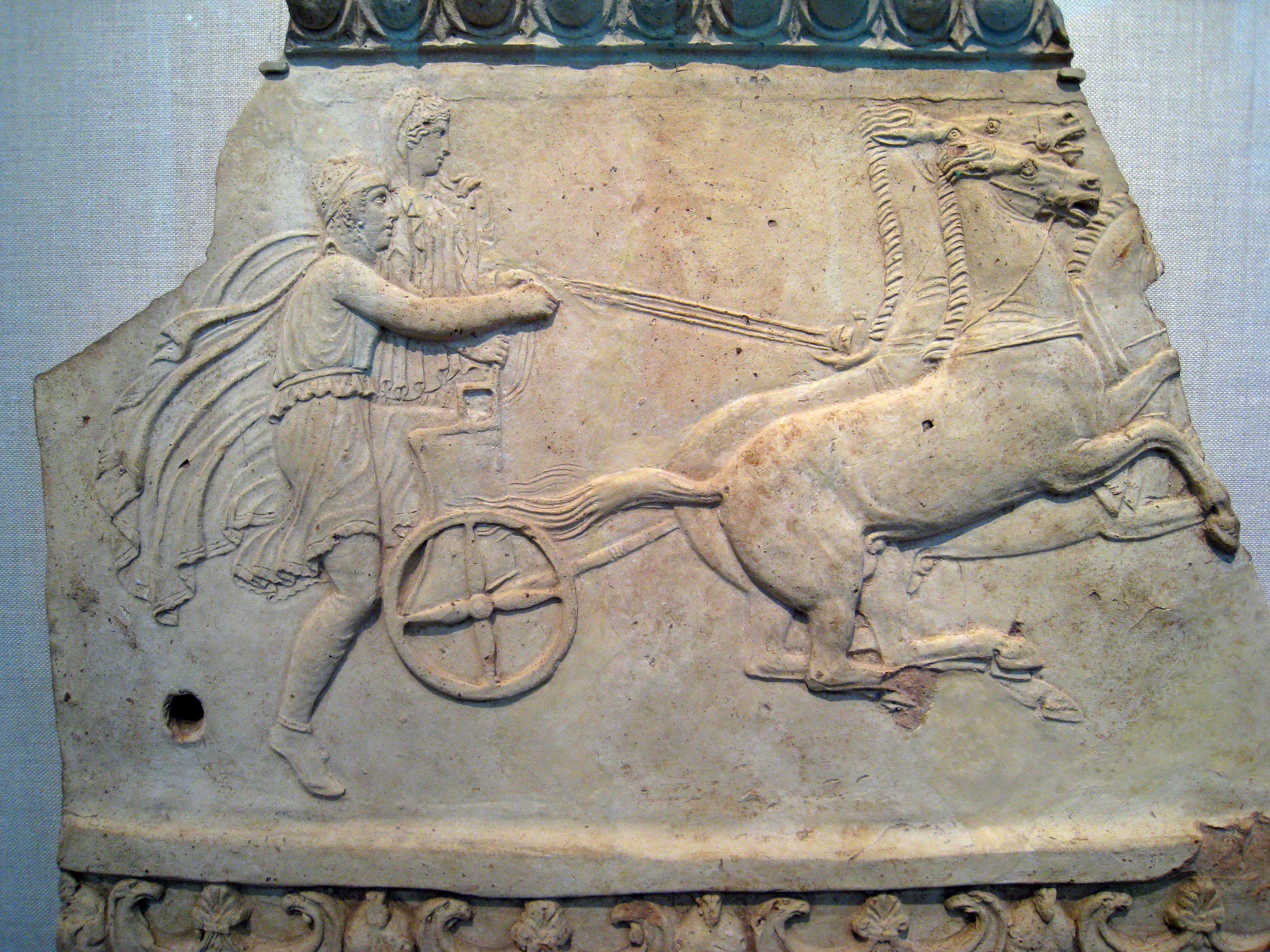|
Lekythion
A lekythion or lecythion, in classical Greek and Latin poetry, is a metric pattern (''colon'') defined by a sequence of seven alternating long and short syllables at the end of a verse (—u—x—u—).Dale, A. M.: ''Lyric Metres of Greek Drama''. Cambridge: Cambridge UP, 1968. p. 20, 215 In classical grammatical terminology it can be described as a trochaic dimeter catalectic, i.e. a combination of two groups of two trochees each (—u—x), with the second of these groups lacking its final syllable; or as a trochaic hepthemimer, i.e. a trochaic sequence of seven half-feet.Liddell, Henry George, & Robert Scott, ''A Greek-English Lexicon'', s.v. " A lekythion can appear in several different metric contexts in different types of poetry, either alone as a verse or as the second of two ''cola'' following a caesura. A frequent type of occurrence in Greek drama is in lines of iambic trimeter, the most frequent metre used in spoken dialogue, i.e. lines of the type x—u—x—u—x—u†... [...More Info...] [...Related Items...] OR: [Wikipedia] [Google] [Baidu] |
Lekythos
A lekythos (plural lekythoi) is a type of ancient Greek vessel used for storing oil (Greek λήκυθος), especially olive oil Olive oil is a liquid fat obtained from olives (the fruit of ''Olea europaea''; family Oleaceae), a traditional tree crop of the Mediterranean Basin, produced by pressing whole olives and extracting the oil. It is commonly used in cooking: .... It has a narrow body and one handle attached to the neck of the vessel, and is thus a narrow type of jug, with no pouring lip; the oinochoe is more like a modern jug. In the "shoulder" and "cylindrical" types which became the most common, especially the latter, the sides of the body are usually vertical by the shoulder, and there is then a sharp change of direction as the neck curves in; the base and lip are normally prominent and flared. However, there are a number of varieties, and the word seems to have been used even more widely in ancient times than by modern archeologists. They are normally in Po ... [...More Info...] [...Related Items...] OR: [Wikipedia] [Google] [Baidu] |
Trochaic
In English poetic metre and modern linguistics, a trochee () is a metrical foot consisting of a stressed syllable followed by an unstressed one. But in Latin and Ancient Greek poetic metre, a trochee is a heavy syllable followed by a light one (also described as a long syllable followed by a short one). In this respect, a trochee is the reverse of an iamb. Thus the Latin word "there", because of its short-long rhythm, in Latin metrical studies is considered to be an iamb, but since it is stressed on the first syllable, in modern linguistics it is considered to be a trochee. The adjective form is ''trochaic''. The English word ''trochee'' is itself trochaic since it is composed of the stressed syllable followed by the unstressed syllable . Another name formerly used for a trochee was a choree (), or choreus. Etymology ''Trochee'' comes from French , adapted from Latin , originally from the Greek (), 'wheel', from the phrase (), literally 'running foot'; it is connected with ... [...More Info...] [...Related Items...] OR: [Wikipedia] [Google] [Baidu] |
Iphigenia In Tauris
''Iphigenia in Tauris'' ( grc, Ἰφιγένεια ἐν Ταύροις, ''Iphigeneia en Taurois'') is a drama by the playwright Euripides, written between 414 BC and 412 BC. It has much in common with another of Euripides's plays, '' Helen'', as well as the lost play '' Andromeda'', and is often described as a romance, a melodrama, a tragi-comedy or an escape play. Although the play is generally known in English as ''Iphigenia in Tauris'', this is, strictly speaking, the Latin title of the play (corresponding to the Greek Ἰφιγένεια ἐν Ταύροις), the meaning of which is ''Iphigenia among the Taurians''. There is no such place as "Tauris" in Euripides' play, although Goethe, in his play '' Iphigenie auf Tauris'' (on which Gluck's opera '' Iphigénie en Tauride'' is based), ironically utilising this translation error, posits such a place. The name refers to the Crimean Peninsula (ancient ''Taurikḗ''). Background Years before the time period covered by the pla ... [...More Info...] [...Related Items...] OR: [Wikipedia] [Google] [Baidu] |
Ancient Greek Poetry
Ancient Greek literature is literature written in the Ancient Greek language from the earliest texts until the time of the Byzantine Empire. The earliest surviving works of ancient Greek literature, dating back to the early Archaic period, are the two epic poems the '' Iliad'' and the '' Odyssey'', set in an idealized archaic past today identified as having some relation to the Mycenaean era. These two epics, along with the Homeric Hymns and the two poems of Hesiod, '' Theogony'' and '' Works and Days'', constituted the major foundations of the Greek literary tradition that would continue into the Classical, Hellenistic, and Roman periods. The lyric poets Sappho, Alcaeus, and Pindar were highly influential during the early development of the Greek poetic tradition. Aeschylus is the earliest Greek tragic playwright for whom any plays have survived complete. Sophocles is famous for his tragedies about Oedipus, particularly ''Oedipus the King'' and ''Antigone''. Euripides ... [...More Info...] [...Related Items...] OR: [Wikipedia] [Google] [Baidu] |
Synizesis
Synizesis () is a sound change (metaplasm) in which two originally syllabic vowels (hiatus) are pronounced instead as a single syllable. In poetry, the vowel contraction would often be necessitated by the metrical requirements of the poetic form. Synizesis is also understood to occur as a natural product in the evolution of a language over time. A tie may be used to represent this pronunciation: ''dƒì͡hinc'' (i.e., ''deinc''). Definition ''Synizesis'' comes from the Greek (''syn√≠zƒìsis'', "a sitting together") from (''syn'', "with") and (''hiz≈ç'', "I sit"). The term was used to describe this vowel change as early as the 2nd century CE, by the Alexandrian grammarian, Hephaestion. Ancient grammarians, such as Hephaestion, defined synizesis broadly as the ‚ÄúœÉœçŒªŒªŒ∑œàŒπœÇ‚Äù (''syllepsis'', ‚Äúa taking together (of sounds)‚Äù) of any two syllables. More contemporary scholarship has, however, recognised that, when so constructed, synizesis is given an unjustifiably bro ... [...More Info...] [...Related Items...] OR: [Wikipedia] [Google] [Baidu] |
Phoenissae
''The Phoenician Women'' ( grc, Φοίνισσαι, ''Phoinissai'') is a tragedy by Euripides, based on the same story as Aeschylus' play ''Seven Against Thebes''. It was presented along with the tragedies ''Hypsipyle'' and '' Antiope.'' With this trilogy, Euripides won the second prize. The title refers to the Greek chorus, which is composed of Phoenician women on their way to Delphi who are trapped in Thebes by the war. Unlike some of Euripides' other plays, the chorus does not play a significant role in the plot, but represents the innocent and neutral people who very often are found in the middle of war situations. Patriotism is a significant theme in the story, as Polynices talks a great deal about his love for the city of Thebes but has brought an army to destroy it; Creon is also forced to make a choice between saving the city and saving the life of his son. Euripides wrote the play around 408 BC, amid military disasters for his homeland, Athens. Plot The play opens with ... [...More Info...] [...Related Items...] OR: [Wikipedia] [Google] [Baidu] |
Greek Chorus
A Greek chorus, or simply chorus ( grc-gre, χορός, chorós), in the context of ancient Greek tragedy, comedy, satyr plays, and modern works inspired by them, is a homogeneous, non-individualised group of performers, who comment with a collective voice on the dramatic action. The chorus consisted of between 12 and 50 players, who variously danced, sang or spoke their lines in unison, and sometimes wore masks. Etymology Historian H. D. F. Kitto argues that the term ''chorus'' gives us hints about its function in the plays of ancient Greece: "The Greek verb ''choreuo'', 'I am a member of the chorus', has the sense 'I am dancing'. The word ''ode'' means not something recited or declaimed, but 'a song'. The 'orchestra', in which a chorus had its being, is literally a 'dancing floor'." From this, it can be inferred that the chorus danced and sang poetry. Dramatic function Plays of the ancient Greek theatre always included a chorus that offered a variety of background and summary ... [...More Info...] [...Related Items...] OR: [Wikipedia] [Google] [Baidu] |
Hephaestion (grammarian)
Hephaestion ( grc-gre, ·º©œÜŒ±ŒπœÉœÑŒØœâŒΩ ''Hƒìphaist√≠≈çn''; fl. 2nd century AD) was a grammarian of Alexandria who flourished in the age of the Antonines. He was the author of a manual (abridged from a larger work in 48 books) of Greek metres, which is most valuable as the only complete treatise on the subject that has been preserved. The concluding chapter discusses the various kinds of poetical composition. It is written in a clear and simple style, and was much used as a school-book. Works * ''Enchiridion de Metris'' (·ºòŒ≥œáŒµŒπœÅŒØŒ¥ŒπŒøŒΩ œÄŒµœÅ·Ω∂ ŒºŒ≠œÑœÅœâŒΩ) * ''On Confusions in Poems'' (ŒÝŒµœÅ·Ω∂ œÑ·ø∂ŒΩ ·ºêŒΩ œÄŒøŒπŒÆŒºŒ±œÉŒπ œÑŒ±œÅŒ±œá·ø∂ŒΩ) * ''Poemata'' (ŒÝŒµœÅŒØ œÄŒøŒπŒÆŒºŒ±œÑŒøœÇ) * ''Solutions in Tragedy'' (Œ§œÅŒ±Œ≥ŒπŒ∫·ø∂ŒΩ ŒªœçœÉŒµœâŒΩ) * ''Solutions to Difficulties in Comedy'' (ŒöœâŒºŒπŒ∫·ø∂ŒΩ ·ºÄœÄŒøœÅŒ∑ŒºŒ¨œÑœâŒΩ ŒªœçœÉŒµŒπœÇ) Editions * Thomas Foster Barham: ''The Enkheiridion of Hehfaistiown concerning Metres and Poems. Translated into English, and i ... [...More Info...] [...Related Items...] OR: [Wikipedia] [Google] [Baidu] |
Pisa, Greece
Pisa ( grc, ŒÝ·øñœÉŒ±) is a modern village situated to the east of Olympia, Greece. Currently it is not politically independent but is a neighborhood of the village of Archea Olympia, the capital of the Municipality of Ancient Olympia, of which it is a municipal unit, Ancient Olympia, since 2011. Municipality (deme), municipal unit, village, and ancient site, all telescope at the same location under the same Greek name, archaia Olympia, although different English translations provide some diversity at the different levels. They are all in the regional unit of Elis, located on the northwest side of the geographic (not political) feature of the Peloponnesus Modern Pisa is the putative location of ancient Pisa. Greek history tells of a contention between Olympia, Pisa, and Elis, a village of ancient Elis, for supremacy of the region and management of the sacred precinct. The existence of an ancient district called Pisatis (·º° ŒÝŒπœÉ·æ∂œÑŒπœÇ), which included 8 villages over half of ... [...More Info...] [...Related Items...] OR: [Wikipedia] [Google] [Baidu] |
Pelops
In Greek mythology, Pelops (; ) was king of Pisa in the Peloponnesus region (, lit. "Pelops' Island"). He was the son of Tantalus and the father of Atreus. He was venerated at Olympia, where his cult developed into the founding myth of the Olympic Games, the most important expression of unity, not only for the people of Peloponnesus, but for all Hellenes. At the sanctuary at Olympia, chthonic night-time libations were offered each time to "dark-faced" Pelops in his sacrificial pit ('' bothros'') before they were offered in the following daylight to the sky-god Zeus (Burkert 1983:96). Genealogy Pelops was a son of Tantalus and either Dione, Euryanassa, Eurythemista,Scholia ad Euripides, ''Orestes'11/ref> or Clytia. In some accounts, he was called a bastard son of Tantalus while others named his parents as Atlas and the nymph Linos. Others would make Pelops the son of Hermes and Calyce while another says that he was an Achaean from Olenus. Of Phrygian or Lydian birth ... [...More Info...] [...Related Items...] OR: [Wikipedia] [Google] [Baidu] |
Aeschylus
Aeschylus (, ; grc-gre, Αἰσχύλος ; c. 525/524 – c. 456/455 BC) was an ancient Greek tragedian, and is often described as the father of tragedy. Academic knowledge of the genre begins with his work, and understanding of earlier Greek tragedy is largely based on inferences made from reading his surviving plays. According to Aristotle, he expanded the number of characters in the theatre and allowed conflict among them. Formerly, characters interacted only with the chorus.The remnant of a commemorative inscription, dated to the 3rd century BC, lists four, possibly eight, dramatic poets (probably including Choerilus, Phrynichus, and Pratinas) who had won tragic victories at the Dionysia before Aeschylus had. Thespis was traditionally regarded the inventor of tragedy. According to another tradition, tragedy was established in Athens in the late 530s BC, but that may simply reflect an absence of records. Major innovations in dramatic form, credited to Aeschylus by Aristotle ... [...More Info...] [...Related Items...] OR: [Wikipedia] [Google] [Baidu] |
Euripides
Euripides (; grc, Εὐριπίδης, Eurīpídēs, ; ) was a tragedian of classical Athens. Along with Aeschylus and Sophocles, he is one of the three ancient Greek tragedians for whom any plays have survived in full. Some ancient scholars attributed ninety-five plays to him, but the '' Suda'' says it was ninety-two at most. Of these, eighteen or nineteen have survived more or less complete ('' Rhesus'' is suspect). There are many fragments (some substantial) of most of his other plays. More of his plays have survived intact than those of Aeschylus and Sophocles together, partly because his popularity grew as theirs declinedMoses Hadas, ''Ten Plays by Euripides'', Bantam Classic (2006), Introduction, p. ixhe became, in the Hellenistic Age, a cornerstone of ancient literary education, along with Homer, Demosthenes, and Menander.L.P.E.Parker, ''Euripides: Alcestis'', Oxford University Press (2007), Introduction p. lx Euripides is identified with theatrical innovations that ha ... [...More Info...] [...Related Items...] OR: [Wikipedia] [Google] [Baidu] |








